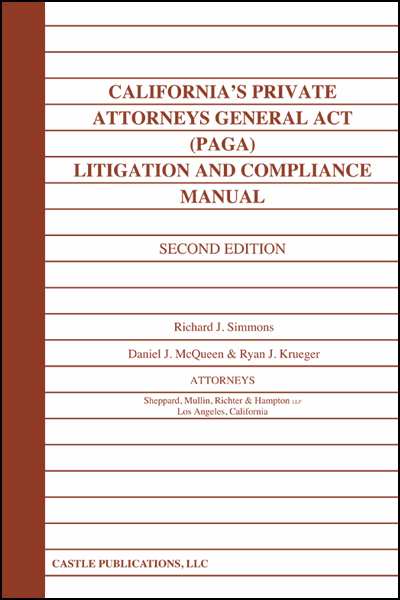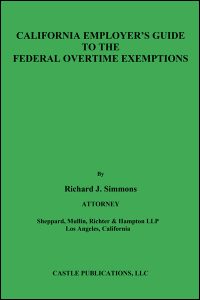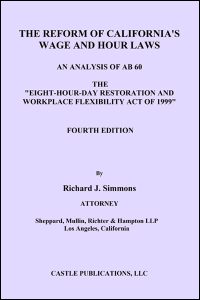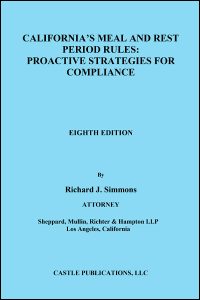Description
Thousands of claims were initiated during the pandemic under the Private Attorneys General Act of 2004 (“PAGA”). This occurred while thousands of businesses were reeling from Stay-At-Home mandates and devastating economic blows. The government has exhibited no sympathy for employers despite the fact that PAGA has operated as a get-rich-quick goldmine for plaintiffs’ attorneys, a devastating weapon against struggling employers, and an odd statute that allows the State to share in 75% of any penalties recovered.
The thousands of employers who have faced PAGA claims agree that PAGA has become the worst enemy for employers in the Labor Code. By allowing current and former employees to act as “private attorneys general” and seek a percentage of all penalties recovered based on hundreds of provisions in the Labor Code, the law has been nicknamed the “Bounty Hunter Law” and the “Sue Your Boss Law” because it motivates employees to sue employers instead of filing grievances. California employers are now hit with as many as 10 to 35 PAGA actions a day. The scope of PAGA and its impact emphasize the need to understand California’s extensive rules and commit to total compliance. In fact, an individual who experiences any alleged Labor Code violation can bring a PAGA action on behalf of other employees who are claimed to have experienced a violation of the same or any different statutory violation. And, employees can bring PAGA actions without having to satisfy the basic standards necessary to pursue a class action.
PAGA penalties for a single Labor Code violation can equal $100 for each employee times the number of pay periods for which the violation lasts. As an example, an employer with 100 employees could face penalties of $10,000 per pay period for just one violation. If the employer uses a weekly pay period and the violation lasts a year, the penalties could be $520,000. Strikingly, the penalties can double for subsequent violations. Worse yet, the statute is entirely one-sided so employees who win are assured recovery of their attorneys’ fees even though employers can never recover their fees under PAGA, even if a case is proved to be baseless.
In this publication, Attorneys Richard J. Simmons, Daniel J. McQueen, and Ryan J. Krueger from the law firm of Sheppard, Mullin, Richter & Hampton LLP examine PAGA from top to bottom. In addition to reviewing every section of the law, the book delves deeply into the cases that have construed it, the hurdles that employees must exhaust before filing a lawsuit, litigation strategies, defenses, the effect of arbitration agreements on PAGA actions, and compliance issues. It includes an in-depth review of the purpose and structure of PAGA, meal period, rest period, pay stub, seating and other claims, trial strategies, damages and remedies.
The publication emphasizes compliance rules and includes a number of checklists. One checklist allows employers to audit their policies and practices. It also provides an extensive review of key cases, including a chapter devoted to the Supreme Court cases in the field since 2004. The authors identify proactive strategies, high risk areas, and valuable guidance designed to aid compliance efforts and reduce exposure to liability.
Among the subjects covered in this publication are:
- The View Of PAGA From The California Supreme Court
- The Importance Of Self-Audits
- The Need To Exhaust Administrative Remedies Before Filing Lawsuits
- Civil Penalties & Remedies
- The Effect Of Arbitration Agreements And Class Action Waivers On PAGA Actions
- The Authority Of Courts To Lower Penalties
- Factors Considered When Awarding Penalties
- Common PAGA Claims Regarding Meal Periods, Rest Periods, And Other Issues
- Suitable Seating Cases
- Significance Of Category 1 And 2 Statutes
- Opportunity To Cure Violations
- Checklists & High Risk Areas
- Liabilities
- Penalty Rules
- Combining PAGA And Class Action Claims In A Single Lawsuit
- The Effect Of PAGA Actions On Appeals Based On The Death Knell Doctrine
- The Distinctions In PAGA-Only Actions
- One-Sided Attorney’s Fee Provision
- Statutes Of Limitations In PAGA Cases
- Avoiding Litigation
- The Effect Of Individual Settlements On PAGA Standing
- The Role Of The State And Courts In PAGA Settlements
- Notification Rules
- Labor Code Checklist
- Role Of Legal Counsel
- Litigation Strategies
- Defenses
- Role Of LWDA
- The Issues Associated With Chindarah v. Pick Up Stix Settlements
Table Of Contents
PREFACE
CHAPTER 1 THE PRIVATE ATTORNEYS GENERAL ACT OF 2004
1.1 The Context In Which PAGA Was Enacted And Its Impact
1.2 PAGA’s Focus On Enforcement
1.3 PAGA Creates New Remedies Without Creating New Substantive Rules
1.4 The Reduced Role Of State Enforcement Agencies
1.5 PAGA’s Enforcement System
1.6 The Relevance Of California’s Class Action Requirements
1.7 Abbreviations Used In The Manual
1.8 Other Important Resources
CHAPTER 2 OVERVIEW OF PAGA
2.1 The Use Of Civil Actions To Enforce California’s Wage And Hour Laws
2.2 Law Enforcement Actions Under PAGA
2.3 Section 558 Claims Against Employers And Individuals
2.4 Minimum Wage Claims Against Employers And Individuals Under Section 1197.1
2.5 Labor Code Section 1198’s Pathway To Wage Order Enforcement
2.6 Varied Motivations For PAGA Actions
2.7 PAGA Establishes A Punishment System While Trivializing The Critical Need For Education And Information
2.8 The Statutory Structure Of PAGA
2.9 The Enactment Of PAGA And Its Amendments
2.10 Key Definitions And Rules In PAGA
2.11 Construction Employees Covered By CBAs Are Excluded From PAGA
2.12 Posting, Notice, Reporting And Filing Violations
2.13 PAGA’s Cure Provisions
2.14 PAGA Statistics
CHAPTER 3 PAGA’S EXHAUSTION, ADMINISTRATIVE AND PROCEDURAL STANDARDS
3.1 Obligations To Provide Proper Notice And Exhaust Administrative Remedies
3.2 The Categories Of Violations Identified In PAGA
3.3 Claims Based On Specified Statutes – Category 1 Statutes
3.4 Claims Based On Other Labor Code Provisions – Category 2 Statutes
3.5 Claims Based On Occupational Safety Violations
3.6 Scope Of Claims That An Aggrieved Employee Can Pursue
CHAPTER 4 REPRESENTATIVE ENFORCEMENT ACTIONS AND CLASS ACTIONS
4.1 Class Action Requirements
4.2 Distinctions Between Class Actions And PAGA Actions
4.3 The Basic Class Action Standards Under California Law In The CCP
CHAPTER 5 THE CALIFORNIA SUPREME COURT’S VIEW OF PAGA
5.1 The California Supreme Court’s Perspective On PAGA
5.2 Arias v. Superior Court: The Inapplicability Of Class Action Standards To PAGA Actions And The Effect Of PAGA Judgments
5.3 Amalgamated Transit Union, Local 1756, AFL-CIO v. Superior Court: A Labor Union Cannot Bring A PAGA Action
5.4 Iskanian v. CLS Transportation Los Angeles, LLC: The Effect Of The FAA And Class Action Waivers
5.5 Williams v. Superior Court: Discovery Rights In PAGA Actions
5.6 Mendoza v. Nordstrom, Inc.: PAGA Authorizes A Representative Action Without The Need For Class Certification
5.7 ZB, N.A. v. Superior Court: Employees Can Pursue Civil Penalties Through PAGA, But Not Claims For Unpaid Wages Or Compensatory Relief
5.8 Kim v. Reins Int’l California, Inc.: Employees Do Not Lose Standing To Pursue PAGA Claims By Settling And Dismissing Their Individual Claims
CHAPTER 6 ITEMIZED WAGE STATEMENT AND PAGA CLAIMS
6.1 California’s Overlapping Wage Statement And PAGA Rules
6.2 Injunctive Relief
6.3 Payroll Companies
6.4 Government Employer Exemption
6.5 Residential Worker Exemption
6.6 Right to Inspect Or Receive A Copy Of Pay Records
6.7 Relationship With Unfair Competition Claims
6.8 PAGA’s Applicability To Pay Stub Violations
6.9 The Overlapping Regulation Of Wage Statements Under PAGA And Labor Code Section 226
6.10 PAGA And Labor Code Section 226 Issues Involving Notice Of Paid Sick Leave
CHAPTER 7 ARBITRATION OF PAGA CLAIMS
7.1 A Waiver Of The Right To Bring A PAGA Claim In Court Cannot Be Enforced
7.2 Under California Authority, Employees Can Only Agree To Arbitrate PAGA Claims After Exhausting Their Administrative Remedies
7.3 Under Ninth Circuit Authority, Predispute Arbitration Agreements Can Be Enforced To Compel The Arbitration Of PAGA Claims
7.4 Agreements To Arbitrate Non-PAGA Claims
CHAPTER 8 LITIGATION CONSIDERATIONS
8.1 Removal And The Class Action Fairness Act
8.2 PAGA And Venue
8.3 The Complexity Of PAGA Actions
8.4 PAGA Discovery – Obtaining Aggrieved Employee Contact Information
8.5 The Need For An Adequate Trial Plan
8.6 Some PAGA Actions Are Unmanageable
8.7 Roles Of Judge vs. Jury
8.8 Bifurcation Of Trials
8.9 Court’s Role In PAGA Penalty Awards
8.10 Establishing A Right To PAGA Penalty Recoveries
8.11 Burden of Proof
8.12 Claims That May Be Brought Under PAGA
CHAPTER 9 REMEDIES
9.1 Penalties Recoverable Under PAGA
9.2 Recovery Of Penalties vs. Victim-Specific Relief
9.3 Courts Have Discretion To Award Lesser Penalties
9.4 Injunctive Relief
9.5 The Effect Of A PAGA Judgment
9.6 The Scope Of PAGA Judgments
CHAPTER 10 DEFENSES IN PAGA LITIGATION
10.1 Failure To Exhaust
10.2 Statutes Of Limitations
10.3 Lack Of Standing And Lack Of Violation
10.4 Motions To Strike
10.5 Other Defenses
CHAPTER 11 SETTLEMENT OF LABOR CODE AND PAGA CLAIMS
11.1 PAGA’s Statutory Framework On Settlement
11.2 Factors Courts Consider When Reviewing PAGA Settlements
11.3 The Res Judicata Impact Of A PAGA Settlement
11.4 Where The Named Plaintiff Has Settled On An Individual Basis
11.5 Using Individual Settlements With Employees To Resolve Claims
CHAPTER 12 APPEALS
12.1 Appeals In PAGA Actions
12.2 The Death Knell Doctrine Does Not Apply Where A Pending PAGA Claim Must Be Adjudicated After Class Certification Is Denied
12.3 Even If The Death Knell Doctrine Does Not Apply, A Reviewing Court Has Discretion To Consider The Merits Of A Premature Appeal By Treating It As A Writ
12.4 A Defendant May Not Appeal An Adverse PAGA Ruling Until A Final Judgment In The Case Is Issued
12.5 PAGA Claims Are Subject To An Automatic Bankruptcy Stay
12.6 The LWDA’s Decision On A Cure Dispute May Be Appealed To The Appellate Division Of The Superior Court
CHAPTER 13 COMPLIANCE AUDITS
13.1 The Legislature’s Emphasis On Compliance
13.2 The Importance Of Self Audits
13.3 Audit Process And Subjects
13.4 Need For Legal Counsel
CHAPTER 14 LABOR CODE CHECKLISTS AND SUMMARIES
14.1 The Pursuit Of Penalties Under The PAGA
14.2 Labor Code Checklist
14.3 High Risk Areas
CHAPTER 15 ADDITIONAL TARGET AREAS FOR AUDITS
CHAPTER 16 LEAVES OF ABSENCE AND TIME OFF RIGHTS
16.1 Overview
16.2 Audit Issues
16.3 Additional Resources
CHAPTER 17 POSTING AND NOTIFICATION OBLIGATIONS
APPENDIX A THE LABOR CODE PRIVATE ATTORNEYS GENERAL ACT OF 2004 Labor Code §§ 2698 – 2699.6
APPENDIX B SB 796 — THE PRIVATE ATTORNEYS GENERAL ACT OF 2004 (Signed October 12, 2003)
APPENDIX C SENATE RULES COMMITTEE REPORT ON SB 796 (September 11, 2003)
APPENDIX D ASSEMBLY FLOOR ANALYSIS OF SB 796 (September 2, 2003)
APPENDIX E SB 899 (Signed April 19, 2004)
APPENDIX F SB 1809 (Signed August 11, 2004, As An Urgency Statute)
APPENDIX G ASSEMBLY FLOOR ANALYSIS OF SB 1809 (July 29, 2004)
APPENDIX H SENATE RULES COMMITTEE REPORT ON SB 1809 (July 29, 2004)
APPENDIX I SB 940 (Effective January 1, 2009)
APPENDIX J AB 1506 (Effective October 2, 2015)
APPENDIX K SB 836 (Effective January 1, 2016)
APPENDIX L AB 235 (Stats. 2018, Ch. 704518) (Effective September 22, 2018)
APPENDIX M AB 1654 (Effective January 1, 2019)
APPENDIX N FORMS OF LABOR & WORKFORCE DEVELOPMENT AGENCY
APPENDIX O LOS ANGELES COUNTY SUPERIOR COURT FORM CREATED TO EVALUATE CLASS ACTION SETTLEMENTS
APPENDIX P LOS ANGELES COUNTY SUPERIOR COURT CLASS ACTION CASE MANAGEMENT ORDER
APPENDIX Q LABOR CODE INDEX
APPENDIX R CASE TABLE
SUBJECT INDEX
About The Authors

Richard J. Simmons is a Partner in the law firm of Sheppard, Mullin, Richter & Hampton LLP in Los Angeles. He represents employers in various employment law matters involving litigation throughout the country and general advice regarding state and federal wage and hour laws, employment discrimination, wrongful discharge, employee discipline and termination, employee benefits, affirmative action, union representation proceedings, and arbitrations. Mr. Simmons received his B.A., summa cum laude, from the University of Massachusetts, where he was a Commonwealth Scholar and graduated in the Phi Kappa Phi Honor Society. He received his J.D. from Berkeley Law at the University of California at Berkeley where he was the Editor-in-Chief of the Industrial Relations Law Journal, now the Berkeley Journal of Employment and Labor Law.
Mr. Simmons argued the only case before the California Supreme Court that produced a victory for employers and business in 2018. He was recently recognized as the Labor and Employment Attorney of the Year by the Los Angeles Business Journal and was inducted into the Employment Lawyers Hall of Fame. He has lectured nationally on wage and hour, employment discrimination, wrongful termination, and other employment and labor relations matters. He is a member of the National Advisory Board to the Berkeley Journal of Employment and Labor Law, published by Berkeley Law at the University of California at Berkeley. He was also appointed by the California Industrial Welfare Commission as a member of three Minimum Wage Boards for the State of California.

Daniel J. McQueen is a Partner with Sheppard, Mullin, Richter & Hampton LLP in the firm’s Los Angeles Office. Mr. McQueen handles all facets of the litigation process in labor and employment disputes. Mr. McQueen has jury trial experience; has taken and defended numerous depositions; written and argued motions for summary judgment; and provided advice on human resources and personnel issues. He has been involved in labor and employment disputes under both state and federal law, including discrimination on the basis of race, sex, age, religion, disability, gender identity and sexual orientation. He has specific experience under the California Fair Employment and Housing Act, Title VII, the Age Discrimination in Employment Act, the Americans with Disabilities Act, the Family Medical Leave Act, and other labor and employment laws.
Mr. McQueen has significant experience in defending wage and hour class actions, including claims for overtime pay, meal and rest period violations, and vacation pay. In particular, Mr. McQueen has represented restaurants, retailers, hospitals, and grocery store chains in the defense of wage and hour class actions.
Mr. McQueen received his undergraduate degree from Occidental College and graduated from the University of California, Los Angeles, School of Law. He is admitted to practice in all California State Courts, along with the United States District Court for the Central District of California.

Ryan J. Krueger is an attorney with Sheppard, Mullin, Richter & Hampton LLP in the firm’s Los Angeles office. He specializes in labor and employment matters on behalf of employers, including wage and hour violations, employment discrimination, wrongful termination and sexual harassment. Mr. Krueger has experience in all aspects of employment litigation, including brief writing and oral argument, taking and defending depositions, and negotiating settlements. He has also second chaired multiple trials and arbitrations, and argued before the California Court of Appeal. Mr. Krueger also regularly counsels employers regarding California and federal employment law issues.
Ryan is a co-author of the 2021 edition of the California’s Private Attorneys General Act (PAGA) Litigation and Compliance Manual, a contributing author to the Employer’s Guide to COVID-19 and Emerging Workplace Issues and the ALERT Newsletter. He received his J.D. from the University of California, Los Angeles and his B.A. from the University of Wisconsin, with distinction. During law school, Mr. Krueger served as extern to the Honorable Morton Denlow, U.S. District Court for the Northern District of Illinois. He is admitted to practice in all California state courts, along with the United States District Court for the Central District of California and the Ninth Circuit Court of Appeals.







